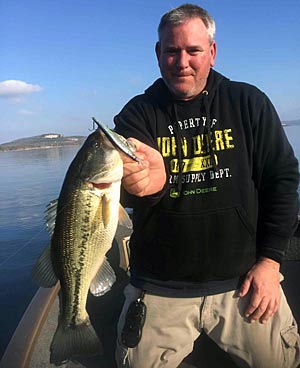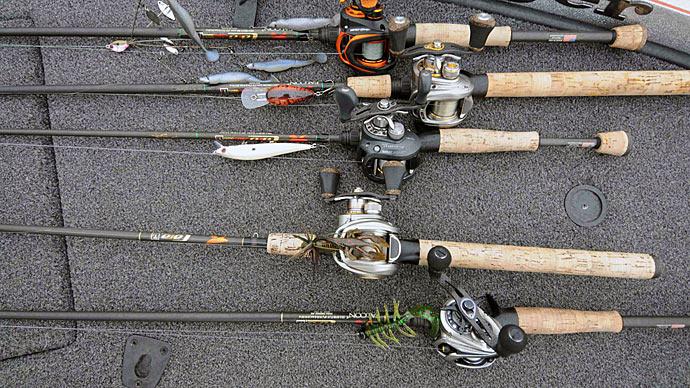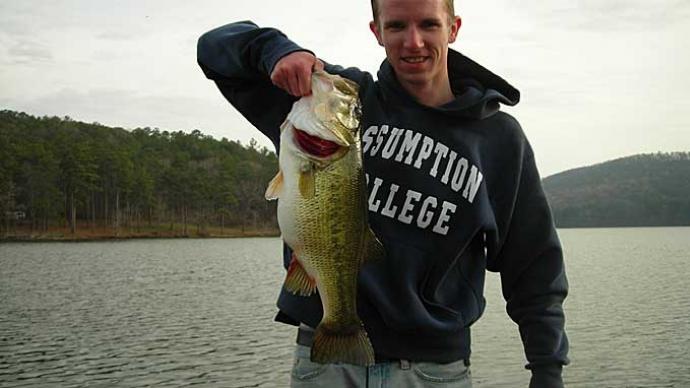
Heavyweight bass leave their wintertime haunts when the water temperature slowly rises and daylight hours lengthen in late winter and start migrating to spawning sites.
Along their way to the spawning banks, the fish will make a couple of stops at transition spots and wait for the arrival of spring to trigger their urge to procreate. Table Rock Lake guide Steve Dickey tries to intercept these prespawn bass during their transition from winter to spring. “They move from an open water suspended stage and transition into the pockets,” Dickey says. “They still want to be right next to really deep water but also where there is a spawning pocket real close.”
In early winter, Dickey finds Table Rock bass on channel swings in creeks or on the main lake. During late winter, he notices the fish move onto secondary points or into short pockets in the creek arms. He looks for the banks with more gravel leading into a protective pocket.
During their migration to the spawning pockets, prespawn bass in the late winter first stage on transition banks where the rocks change from bluff and ledges to chunk rocks. Their next move is to banks where the rocks transition from chunk rocks to pea gravel.
The sweet spot on transition banks is usually the most pronounced section of rock change, from ledge to chunk or gravel. Any cover, such as standing timber on the transition bank, will also draw prespawn bass. Dickey typically finds late winter bass in the standing timber on the bluff ends. “They will get on that pretty thick at times,” he says. “Then, the fish will slide over to the chunk rock if it gets warm and breezy.”
Bass gradually move to the transition banks depending on how long winter lasts. “There are some bass there all winter,” Dickey says. “They live there, but the others start trickling in. Sometimes there will be big numbers on the right spot.” Dickey discovers the largest numbers of prespawn bass move to the transition banks when the water temperature climbs above 50 degrees. The guide notes the prespawn bass on the transition banks are some of the biggest fish he catches all year.
Dickey usually finds these bass suspended 6 to 12 feet deep over 15 to 18 feet of water. “They are just sitting right where there is 6 to 8 feet on a gravel bottom, and then it drops right on a roll-off into 25 to 30 feet,” he says.
Weather determines whether the bass will move shallower or deeper on the transition banks. “If we get a sunny, breezy day, the fish will move up, and I will catch them in 4 to 5 feet very close to the rocks,” Dickey says. “If there is a cold front, they will slide off that bank, and I will catch them more halfway between the boat and the bank versus having them 3 to 5 feet off the bank.”
If the cold weather lingers, prespawn bass will remain on the transition banks. “They just slide out a little deeper,” Dickey says. The guide notices bass will congregate more on a transition bank during a cold front but will scatter in the shallows on warm, sunny days.

The Table Rock guide tricks transition bass with two lures: a suspending jerkbait and a float-and-fly rig. Dickey favors the float-and-fly setup when the water temperature is in the upper 30s and low 40s. The suspending stickbait produces best for him in water temperatures above 40 degrees.
Dickey opts for Luckycraft and Megabass suspending jerkbaits in various colors. In the morning, Dickey prefers throwing stickbaits with a tint of chartreuse or orange on the lure’s belly. On sunny afternoons he favors stickbaits with a foil finish for added flash. Stickbaits in a natural color such as Tennessee shad work best for Dickey in sunny, calm weather.
A neutrally buoyant stickbait is Dickey’s preference for late winter bass. Dickey will throw a stickbait that sinks slightly but never uses one that rises.
Dickey experiments with his stickbait retrieve until he finds a cadence bass prefer. He typically starts in the morning with a presentation of a couple of twitches of the rod, followed by a pause of 6 to 8 seconds. On sunny afternoons, he will fish closer to the bank and speed up his retrieve with harder jerks of the rod and shorter pauses (three to four seconds).
Dickey’s float-and-fly setup consists of a 1/32-ounce hair jig set 9 to 11 feet below a small fixed Thill or Mr. Crappie Rattlin’ Pearl Float. He throws the rig on 6-pound line with a 9-poot spinning rod.
The Missouri angler usually casts the float and fly to timber along the bluff ends or to the rock change spots on the transition banks. He lets the rig sit for 6 to 10 seconds and then jerks his rod to make the float pop on the surface. Dickey suggests a bite is usually easy to detect because a bass will rapidly pull down the float.
BassResource may receive a portion of revenues if you make a purchase using a link above.




